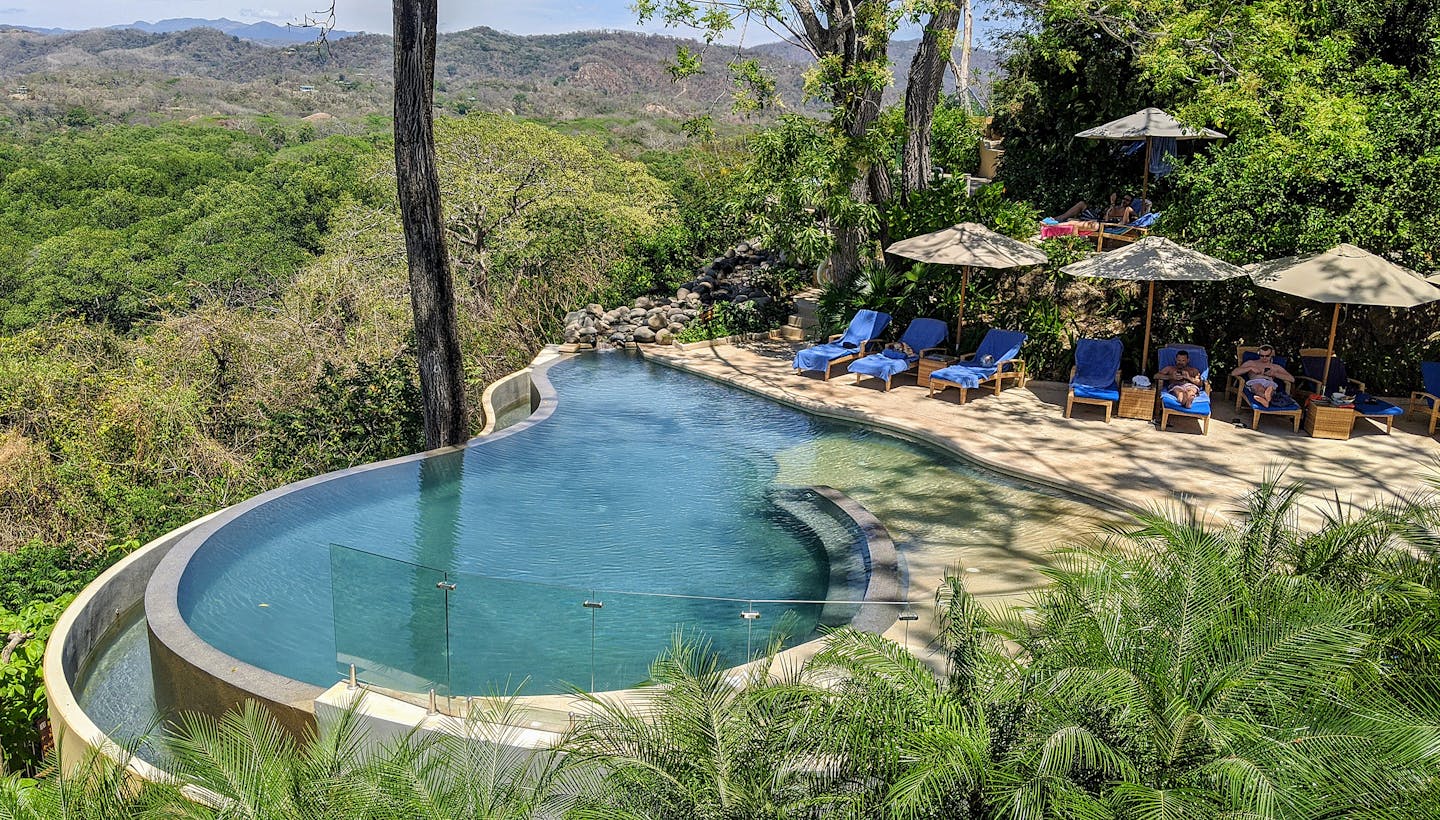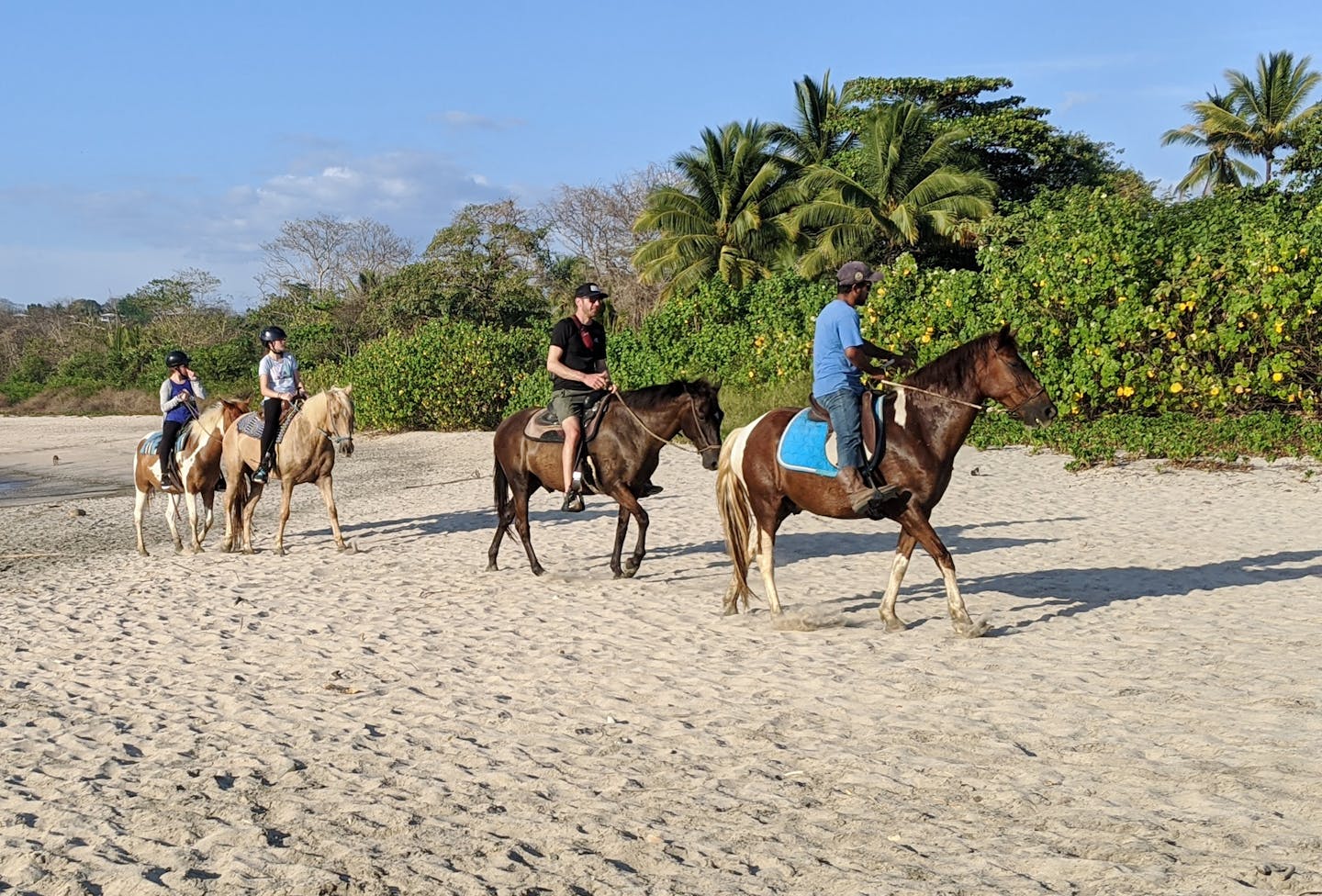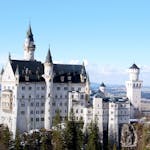The road to Nosara is unpaved, with good intentions.
After a two-hour highway journey to Costa Rica's Pacific coast, the route turns rocky, potholed and narrow. You begin to slow down, dodging trucks and livestock. In arid February, dust coats the lush roadsides, creating a clay-colored trench in the tropical dry forest. There is no indication that this is a road to anywhere — certainly not a sprawling paradise for vacationers, surfers, yogis and expatriates.
Still, the GPS voice eventually instructed me to turn left, so I guided my rental Toyota up an even rougher, snaking trail to the Hotel Boutique Lagarta Lodge, where the welcome sign read "Bad roads bring good people." It was Leap Day 2020, six days before the novel coronavirus was first confirmed in Costa Rica, and 11 days before it was declared a global pandemic.
Our concierge, Erwin, led my companion and me past a heart-shaped infinity pool, up to an open-air lounge, where we were served gingery welcome cocktails and were struck by the panoramic view. The vast jungle below us was bracketed by small mountains and a wild, empty beach that stretched to the horizon. We luxuriated in the 96-degree afternoon heat.
Nosara is hard to get to and even harder to leave. On the other hand, it's surprisingly accessible. In the winter, two airlines fly nonstop from Minneapolis-St. Paul to the small city of Liberia in the western Guanacaste province. Before the pandemic, the route carried about 25,000 passengers a year.
This year, the flights continue through early April, with some airfares below $300 — about half of what I paid in 2020. All adult tourists are required to either show proof of vaccination or purchase insurance for medical and quarantine expenses. Private establishments may also require vaccination, and the country is serious about masking on public transportation and in public spaces. But as we found in Nosara in 2020, there was little reason to interact with people indoors — or even be indoors, beyond our king suite.
Many landing at Liberia will turn inland for a classic Costa Rica experience of volcanoes and rain forests. Others will look west to the beaches, where the path of least resistance (and least potholes) leads to mega-resort towns like Tamarindo. Those in the know head farther down the Nicoya Peninsula, to Nosara and beyond.
I had heard about Nosara for years, thanks to fitness instructors raving about its yoga retreats and surf camps, to name two of its key pursuits. Its community of American hippie expats dates at least to the 1970s. It's still not uncommon to hear a story about an American family packing up and moving there permanently — and that was before the pandemic.
Modern lodging ranges from four-star resorts to low-key beach hotels and hostels. I chose Lagarta Lodge when I learned that it boasts its own wildlife reserve and a commitment to sustainable tourism. I'd been to ecolodges, but having your own reserve sounded next-level. All of the guest rooms have that same soaring balcony view, but every spot feels secluded. The whole place blends clandestinely into the cliffside — Frank Lloyd Wright in the tropics.
A sign in our room advised locking our sliding patio doors, or the coatis (a sort of long-nosed raccoon) would cleverly open them and steal the sugar for the espresso maker. I shooed one trying to do just that while waking up one morning. But most nights, we were content to turn off the AC, throw open the glass doors and fall asleep listening to the wind and crashing surf, followed at dawn by the guttural growls of howler monkeys.
Out of the bubble
A Lagarta guest could spend most or all of their time in the resort bubble, lounging by the infinity pool, and that plan sounds perfectly enchanting — especially with one of the best restaurants in town, Chirriboca, on the broad open-air deck. Every morning we would start with the national breakfast dish of gallo pinto (black beans and rice) with eggs, plantains and a slab of fried cheese — or switch it up with the spicier "Huevos a caballo'' ranchero version, all while gazing down at early-bird surfers on Nosara Beach.
At nightfall, Chirriboca brings in people from all over Nosara for relatively dressy, contemporary Latin dining; I'm still remembering the chef's artsy, substantive fusion of a trout filet and a whole avocado, served over an elote corn risotto, or the Caribbean snapper coated in a tangy ginger-coconut sauce — all enjoyed while a brilliant planet Venus descended nightly upon that same beach.
But I'm too restless to be confined to the resort walls. Laura, the winsome director of guest relations, approached us at breakfast. After we detailed our wish lists, she returned with a neon post-it note listing a reserved schedule for the week: surfing lessons that afternoon, followed by daily tours of the nature reserve and greater Nosara. My partner Sabrina would take a yoga class (with Laura doubling as the instructor) while I was out on a kayak tour.
It was a relief to surrender to a plan, one with plenty of built-in downtime. Sabrina had to work three days, but between the infinity pool, the lounge and the view from our room, she basically had the best remote office of all time, and there was plenty of time after work to hit the beach or a horseback tour. Only weeks later, we were wishing we could return to Lagarta for the new phenomenon of working-from-home.
We boarded a shuttle to Nosara Surf School, in a snug district of bars and shops near Playa Guiones, the legendary surfing beach. We met our instructor, Chico, caked our faces with sunblock resembling stage makeup, and walked our boards to the beach, where we were thrust into the midday sand inferno. Despite Chico's valiant efforts, we couldn't make much progress before seeking refuge from the high sun. Chico admitted surprise that we had booked a 1 p.m. lesson, and I learned that prime time for activities is morning and late afternoon, with relaxation in between.
We recovered with watermelon-coconut smoothies and a banana coffee from a nearby juice truck, then wandered onto the leafy patio of an establishment called Luv Burger for a pair of delicious veggie-based sliders. Sabrina hailed a three-wheeled "tuk tuk" taxi, and I hiked back to the lodge to learn the lay of the land.
What tourists call Nosara is a tangle of neighborhoods hidden behind two main beaches: long Playa Guiones and cozy Playa Pelada. The secret to Nosara's beauty is that it sits along the Ostional National Wildlife Refuge, a prime nesting ground for sea turtles where development is restricted within 200 meters of high tide. Whereas in towns like Tamarindo the hotels and restaurants loudly abut the beach, in Nosara all new development is nestled in the woods, and the broad beaches are the better for it.
Come early evening, intimate Playa Pelada becomes a social hub. Seawater erupts through a tidal blowhole formed in volcanic rock. Horseback riders ply the sands, and would-be influencers stage golden-hour photo shoots. Diners fill up the sandy courtyard of the Mediterranean-inspired La Luna — one of the only "grandfathered" structures on the beach — and Costa Ricans gather on blankets for the nightly sunset-watching ritual. At dusk, everyone disappears back into the jungle.
Hospitality on tour
Monday morning, I joined the kayaking tour with Jiaro, a naturalist from Lagarta Lodge's wildlife reserve, and a young family from Nantucket, Mass. In the heart of the reserve, we pushed off into the lazy Rio de la Montaña. During an hour's paddle, we floated beneath branches occupied by howler monkeys, including infants learning to swing by their tails. As I zoned out on the water, the Nantucket clan became alarmed, wildly gesturing to my left. A crocodile was lounging on a sandbar about 15 feet from my boat.
The family bailed mid-tour, so Jiaro led me on a private paddle up another strand of the river. Landing on a peninsula in view of the ocean, Jiaro produced a machete and opened up a green coconut, serving me a refreshing Costa Rican drink of pipa fria (coconut water).
Almost every interaction I had included hospitality like this as a matter of course. On our horseback ride we snaked through the wildlife reserve, emerged along the beach and trotted through the waves. Our guide ducked into an outdoor dive bar to buy us beers, allowing me to try out holding the reins in one hand, a cerveza in the other, while monkeys chattered on power lines overhead.
At dawn, I joined a walking tour through the reserve, stepping through a bone-dry mangrove forest on raised steps fashioned from logs. The naturalist, Carlos, quietly helped guests spot motley tropical birds — the long-tailed manakin, the white-throated magpie-jay — and led us to pochote trees with terrifying spikes covering their green trunks, as well as the towering guanacaste, the national tree that gives this province its name.
The same guide, Carlos, met me later for a mountain-bike tour. He steered me to a historic cemetery for the area's early settlers, laughing when I asked if it was the resting place of surfers. We stopped at Beach Dog Cafe for an afternoon drink, where he talked about his lifelong commitment to Costa Rican nature. He nodded in agreement with a hostel sign that read, "Welcome Home, Feel Free to Be Yourself."
When I glanced at my phone, a cascade of notifications hinted at a growing sense of alarm back home. While I had been blissed out for four days in Nosara, I vaguely sensed that people were starting to freak out about this so-called coronavirus.
I turned off my phone and put it away. The world's problems felt thousands of miles away, and I wasn't ready to wake up to it yet.











![The American Queen in port at La Crosse, Wis. ] Photo by KERRI WESTENBERG/Star Tribune](https://arc.stimg.co/startribunemedia/PSGWHJEDDXXRV4ID7SU65U7NNA.jpg?w=75&h=75&fit=crop&crop=faces)